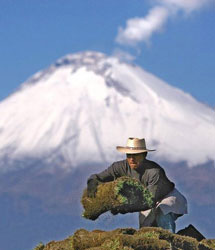 |
 |
 |
 News Around the Republic of Mexico | December 2005 News Around the Republic of Mexico | December 2005  
Mexico's Snowy 'Smoking Mountain' Spits Ash, Rocks
 Reuters Reuters


| | A farmer stacks his crop while the Popocatepetl volcano fumes in the background near Puebla, Mexico. (PRonaldo Schemidt/AFP) |
Mexico City - Mexico's giant Popocatepetl volcano threw up an ash column almost 2 miles (3 km) high and spat glowing rocks down its snow-clad slopes on Sunday, but nearby towns were not affected, officials said.

Popocatepetl, whose name means "smoking mountain" in the Nahuatl Indian language spoken by the Aztecs, spewed out the huge plume of ash and rocks in a three-minute exhalation.

"The recent activity is within the expected scenarios and there is no evidence of a major risk in the following days," said the disaster prevention center Conapred.

"No reports of ash fall have been received."

Sunday's activity was the latest in a recent series of disturbances which started Dec. 1, when the 17,887 foot (5,452 meter) volcano showered ash on the nearby town of Amecameca.

Popocatepetl, which on clear days can be seen from Mexico City, 40 miles (64 km) away and home to some 18 million people, reawakened in 1994 after decades of inactivity.

It has sparked to life several times since then, most notably in 2000 when it tossed red-hot rocks far above its crater in a series of explosions. Tens of thousands of people living nearby were evacuated at that time.

Scientists say the volcano's last major eruption was more than 1000 years ago, while the Valley of Mexico's pre-Hispanic Aztec residents recorded minor eruptions.

The volcano becomes more active during the cooler Mexican winter months as more ice expands and causes fissures in solidified lava in the crater, allowing smoke, ash or molten lava to spew out. | 
 | |
 |



